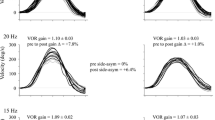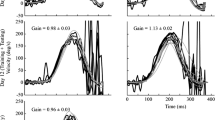Summary
The vestibulo-ocular reflex (VOR) is under adaptive control which corrects VOR performance when visual-vestibular mismatch arises during head movements. However, the dynamic characteristics of VOR adaptive plasticity remain controversial. In this study, eye movements (coil technique) were recorded from normal human subjects during sinusoidal rotations in darkness before and after 8 h. of adaptation to 2X binocular lenses. The VOR was studied at 7 frequencies between 0.025 and 4.0 Hz at 50°/s peak head velocity (less for 2.5–4 Hz). For 0.025 and 0.25 Hz, the VOR was tested at 4 peak head velocities between 50 and 300° /s. Before 2X lens adaptation, VOR gain was around 0.9 at 2.5–4.0 Hz and dropped gradually with decreasing frequency to under 0.6 at 0.025 Hz. Phase showed a small lead at the highest frequencies which declined to 0° as frequency decreased to 0.5–0.25 Hz, but then rose to 14° by 0.025 Hz. VOR gain was independent of head velocity in the range 50–300°/s at both 0.025 and 0.25 Hz. However, Phase lead rose with increasing head velocity, more so at 0.025 than at 0.25 Hz. After 2X lens adaptation, gain rose across the frequency bandwidth. However, the proportional gain enhancement was frequency dependent; it was greatest at 0.025 Hz (44%), and declined with increasing frequency to reach a minimum at 4 Hz (19%). Phase lead increased after 2X lens adaptation at lower frequencies, but decreased at higher frequencies. New velocity-dependent gain nonlinearities also developed which were not present prior to adaptation; gain declined as peak head velocity increased from 50 to 300°/s at both 0.025 (23% drop) and 0.25 Hz (15% drop). This may suggest an amplitude-dependent limitation in VOR adaptive plasticity. Results indicate both frequency and amplitude dependent nonlinearities in human VOR response dynamics before and after adaptive gain recalibration.
Similar content being viewed by others
References
Allum JH, Yamane M, Pfaltz CR (1988) Long-term modifications of vertical and horizontal vestibulo-ocular reflex dynamics in man. Acta Otolaryngol (Stockh) 105: 328–337
Baloh RW, Honrubia V, Yee RD, Hess K (1984a) Changes in the human vestibulo-ocular reflex after loss of peripheral sensitivity. Ann Neurol 16: 222–228
Baloh RW, Lyerly K, Yee RD, Honrubia V (1984b) Voluntary control of the human vestibulo-ocular reflex. Acta Otolaryngol (Stockh) 97: 1–6
Barnes GR, Benson AJ, Prior AR (1978) Visual-vestibular interaction in the control of eye movement. Aviat Space Environ Med 49: 557–564
Barr CC, Schultheis LW, Robinson DA (1976) Voluntary, non-visual control of the human vestibulo-ocular reflex. Acta Otolaryngol (Stockh) 81: 365–375
Cohen B, Henn V, Raphan T, Dennett D (1981) Velocity storage, nystagmus, and visual-vestibular interactions in humans. Ann N Y Acad Sci 374: 421–433
Collewijn H (1977) Eye and head movements in freely moving rabbits. J Physiol (Lond) 266: 471–498
Collewijn H, Martins AJ, Steinman RM (1983) Compensatory eye movements during active and passive head movements: fast adaptation to changes in visual magnification. J Physiol (Lond) 340: 259–286
Collewijn H (1985) Integration of adaptive changes of the optokinetic reflex, pursuit and the vestibulo-ocular reflex. In: Berthoz A, Melvill Jones G (eds) Reviews of oculomotor research, Vol I. Adaptive mechanisms in gaze control. Elsevier, Amsterdam New York Oxford, pp 51–69
Demer JL, Porter FI, Goldberg J, Jenkins HA, Schmidt K (1989) Adaptation to telescopic spectacles: vestibulo-ocular reflex plasticity. Invest Ophthalmol Vis Sci 30: 159–170
Ebisawa Y, Minamitani H, Mori Y, Takase M (1988) New methods for removing saccades in analysis of smooth pursuit eye movement. Biol Cybern 60: 111–119
Fetter M, Zee DS (1988) Recovery from unilateral labyrinthectomy in rhesus monkey. J Neurophysiol 59: 370–393
Furman JM, O'Leary DP, Wolfe JW (1982) Dynamic range of the frequency response of the horizontal vestibulo-ocular reflex of the alert rhesus monkey. Acta Otolaryngol (Stockh) 93: 81–91
Furst EJ, Goldberg J, Jenkins HA (1987) Voluntary modification of the rotatory induced vestibuloocular reflex by fixating imaginary targets. Acta Otolaryngol (Stockh) 103: 232–240
Gauthier GM, Piron JP, Roll JP, Marchetti E, Martin B (1984) High-frequency vestibulo-ocular reflex activation through forced head rotation in man. Aviat Space Environ Med 55: 1–7
Gauthier GM, Robinson DA (1975) Adaptation of the human vestibulo-ocular reflex to magnifying lenses. Brain Res 92: 331–335
Godaux E, Halleux J, Gobert C (1983) Adaptive change of the vestibulo-ocular reflex in the cat: the effects of a long-term frequency-selective procedure. Exp Brain Res 49: 28–34
Gonshor A, Melvill Jones G (1976) Extreme vestibulo-ocular adaptation induced by prolonged optical reversal of vision. J Physiol (Lond) 256: 381–414
Grossman GE, Leigh RJ, Abel LA, Lanska DJ, Thurston SE (1988) Frequency and velocity of rotational head perturbations during locomotion. Exp Brain Res 70: 470–476
Grossman GE, Leigh RJ, Bruce EN, Huebner WP, Lanska DJ (1989) Performance of the human vestibulo-ocular reflex during locomotion. J Neurophysiol 62: 264–272
Hydén D, Istl YE, Schwarz DWF (1982) Human visuo-vestibular interaction as a basis for quantitative clinical diagnostics. Acta Otolaryngol (Stockh) 94: 53–60
Istl-Lenz Y, Hydén D, Schwarz DWF (1985) Response of the human vestibulo-ocular reflex following long-term 2X magnified visual input. Exp Brain Res 57: 448–455
Ito M (1975) Learning control mechanisms by the cerebellum investigated in the flocculo-vestibulo-ocular system. In: Tower DB (ed) The nervous system, Vol 1. The basic neurosciences. Raven Press, New York, pp 245–252
Jell RM, Stockwell CW, Turnipseed GT, Guedry FE (1988) The influence of active versus passive head oscillation, and mental set on the human vestibulo-ocular reflex. Aviat Space Environ Med 59: 1061–1065
Jenkins HA (1985) Long-term adaptive changes of the vestibulo-ocular reflex in patients following acoustic neuroma surgery. Laryngoscope 95: 1224–1234
Larsby B, Hydén D, Ödkvist LM (1984) Gain and phase characteristics of compensatory eye movements in light and darkness. Acta Otolaryngol (Stockh) 97: 223–232
Lisberger SG, Miles FA, Optican LM, Eighmy BB (1981) Optokinetic response in monkey: underlying mechanisms and their sensitivity to long-term adaptive changes in vestibuloocular reflex. J Neurophysiol 45: 869–890
Lisberger SG, Miles FA, Optican LM (1983) Frequency-selective adaptation: evidence for channels in the vestibulo-ocular reflex? J Neurosci 3: 1234–1244
Melvill Jones G (1985) Adaptive modulation of VOR parameters by vision. In: Berthoz A, Melvill Jones G (eds) Reviews of oculomotor research, Vol I. Adaptive mechanisms in gaze control. Elsevier, Amsterdam New York Oxford, pp 21–50
Miles FA, Eighmy BB (1980) Long-term adaptive changes in primate vestibuloocular reflex. I. Behavioral observations. J Neurophysiol 43: 1406–1425
Niven JI, Hixson WC, Correia MJ (1965) An experimental approach to the dynamics of the vestibular mechanisms. In: Symp “Role of the vestibular organs in space exploration”. NASA SP-77, Pensacola, pp 43–56
Paige GD (1983a) Vestibuloocular reflex and its interactions with visual following mechanisms in the squirrel monkey. I. Response characteristics in normal animals. J Neurophysiol 49: 134–151
Paige GD (1983b) Vestibuloocular reflex and its interactions with visual following mechanisms in the squirrel monkey. II. Response characteristics and plasticity following unilateral inactivation of horizontal canal. J Neurophysiol 49: 152–168
Paige GD (1989) Nonlinearity and asymmetry in the human vestibulo-ocular reflex. Acta Otolaryngol (Stockh) 108: 1–8
Pulaski PD, Zee Ds, Robinson DA (1981) The behavior of the vestibulo-ocular reflex at high velocities of head rotation. Brain Res 222: 159–165
Raphan Th, Matsuo V, Cohen B (1979) Velocity storage in the vestibulo-ocular reflex arc (VOR). Exp Brain Res 35: 229–248
Robinson DA (1963) A method of measuring eye movement using a scierai search coil in a magnetic field. IEEE Trans Biomed Eng BME-10: 137–145
Robinson DA (1981) Control of eye movements. In: Brooks VB (ed) The nervous system. Handbook of physiology, Vol. II, Part 2. Williams & Wilkins, Baltimore, pp 1275–1320
Sargent EW, Paige GD (1988) Visually-induced Plasticity in the vestibulo-ocular reflex (VOR): response dynamics and linearity. Invest Ophthalmol Vis Sci Suppl 29: 342
Schwarz DWF, Tomlinson RD (1979) Diagnostic precision in a new rotatory vestibular test. J Otolaryngol 8: 544–548
Skavenski AA, Hansen RM, Steinman RM, Winterson BJ (1979) Quality of retinal image stabilization during small natural and artificial body rotations in man. Vision Res 19: 675–683
Tijssen MA, Straathof CS, Hain TC, Zee DS (1989) Optokinetic afternystagmus in humans: normal values of amplitude, time constant, and asymmetry. Ann Otol Rhinol Laryngol 98: 741–746
Author information
Authors and Affiliations
Rights and permissions
About this article
Cite this article
Paige, G.D., Sargent, E.W. Visually-induced adaptive plasticity in the human vestibulo-ocular reflex. Exp Brain Res 84, 25–34 (1991). https://doi.org/10.1007/BF00231759
Received:
Accepted:
Issue Date:
DOI: https://doi.org/10.1007/BF00231759




